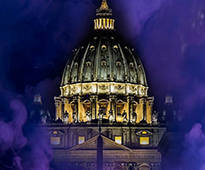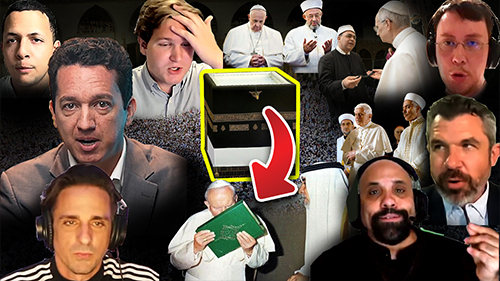| Recent Featured Videos and Articles | Eastern “Orthodoxy” Refuted | How To Avoid Sin | The Antichrist Identified! | What Fake Christians Get Wrong About Ephesians | Why So Many Can't Believe | “Magicians” Prove A Spiritual World Exists | Amazing Evidence For God | News Links |
| Vatican II “Catholic” Church Exposed | Steps To Convert | Outside The Church There Is No Salvation | E-Exchanges | The Holy Rosary | Padre Pio | Traditional Catholic Issues And Groups | Help Save Souls: Donate |  |









 " />
" /> " />
" /> " />
" /> " />
" /> " />
" />




Pope Pius XII, Father Feeney and the dogma
One of the reasons that the heretical and deadly Protocol 122/49 gained such momentum in the minds of so many bishops and priests, and was literally able to wipe out belief in the dogma (that those who die as non-Catholics are lost) in almost the entire Catholic world, was because they thought that it had at least the tacit approval of Pope Pius XII. Indeed the document claims that he did approve of it. The bottom-line is that he didn’t sign it, nor did he promulgate it in any manner that would have affected infallibility. It wasn’t even published officially. And obviously no pope could have signed the Protocol because it is quite heretical, as I have shown.
If Pope Pius XII agreed with the Protocol and the persecution of Father Feeney for preaching the dogma, then he was just simply a mortal sinner against the Faith. If he had come out in favor of the Protocol and against Fr. Feeney then he would have been a heretic. If Pope Pius XII had denied the dogma – as did the priests at Boston College, for example – and assented to the stifling of Father Feeney’s apostolic preaching of it, then Pius XII would have become a heretic and an enemy of the Faith.
If Pope Pius XII thought that Father Feeney was preaching his own doctrine for asserting exactly what Pope Gregory XVI asserted in Summo Iugiter Studio and what the Chair of Peter has dogmatically defined (that all those who die as non-Catholics are lost), then he didn’t understand the first thing about the Catholic Faith – and indeed he did not possess it.
People need to remember that not every decision by a pope is infallible. In studying papal errors throughout history in preparation for its declaration of papal infallibility, the theologians at Vatican I found that over 40 popes held wrong theological views. But none of these errors were taught by popes from the Chair of St. Peter. In a well known case of papal error, Pope John XXII held the false view that the just of the Old Testament don’t receive the Beatific Vision until after the General Judgment.[1]
Perhaps the clearest case of papal error in Church history is the “Synod of the Corpse” of 897. This was where the dead body of Pope Formosus – who by all accounts was a holy and devoted pope – was condemned after his death by Pope Stephen VII for a number of supposed violations of canon law.[2] This condemnation of Pope Formosus by Pope Stephen VII was overturned by Pope Theodore II and Pope John IX, but favored by Pope Sergius III.[3] This should show us very clearly that not every decision, speech, opinion or judgment of a pope is infallible. A pope is infallible when speaking from the Chair of Peter or reiterating what the Church has always taught in her ordinary and universal Magisterium.
Pope Honorius I was condemned by the III Council of Constantinople for at least furthering the monothelite heresy (the belief that Christ had only one will) in two letters to the Patriarch Sergius. So, just as Pope Honorius I (625-638) was condemned for furthering heresy by the III Council of Constantinople and other ecumenical Councils[4], so too would Pope Pius XII have fallen into heresy if he held that non-Catholics could be saved and supported the persecution of Father Feeney for affirming that they could not.
Remember, Pius XII was by no means a staunch traditionalist. His reforms, omissions and failures paved the way for Vatican II. Just a few things that Pius XII did are:
This last offense was the most serious. With the persecution of Father Feeney, the “authorities” in Boston and Rome not only did not aid Father Feeney in his quest to convert non-Catholics, but actually stopped him! Think about that: The men who were supposed to foster the salvation of souls and conversion to the true Faith actually made it as difficult as possible for Father Feeney to do so. They made his task of delivering Christ’s saving message – that salvation only comes from membership in the Church He established – as hard as they could, while giving millions of non-Catholics the false impression that they were okay in the state of damnation in which they existed. Richard Cushing, the apostate Archbishop of Boston, who first silenced Father Feeney – not over baptism of desire, but over extra ecclesiam nulla salus (outside the Church there is no salvation) – boasted before his death that he had not made a convert in his whole life.[5]
It was on September 24, 1952 that Father Feeney addressed a long, detailed letter to Pius XII. The letter went unanswered. But one month later (in a letter dated Oct. 25, 1952) Cardinal Pizzardo of the Holy Office summoned him to Rome. On October 30, 1952, Father Feeney sent a reply to Pizzardo, requesting a statement of the charges against him – as required by Canon Law. On Nov. 22, 1952, Pizzardo replied:
This exchange of letters between Father Feeney and Pizzardo is very interesting and valuable for our discussion. First of all, it shows that Father Feeney’s desire was to operate within the confines of law, whereas Pizzardo and those at the Vatican showed a blatant disregard for law, even in the manner of summoning him to Rome. Canon Law stipulates that a man summoned to Rome must be informed at least in general of the charges lodged against him, and Father Feeney cited the relevant canons. Pizzardo and his cohorts consistently ignored these laws.
Once again, the canonical laws requiring a reason for the summons were completely ignored. But this was just par for the course in the case of Father Feeney: Justice, dogma and Christ’s mandate to preach the Gospel and baptize were ignored and trampled upon. One cannot help but notice the annoyed tone of the cardinal’s letter. There is almost no doubt that Pizzardo also believed that non-Catholics could be saved as non-Catholics, and thus was not at all concerned that the case of Father Feeney was not handled in a just fashion.
Without having been given a reason for his summons to Rome as was required, Father Feeney justifiably stayed in the United States, knowing that his refusal to report to Rome by Jan. 31st might bring bogus canonical penalties down upon his head. But prior to that, on Jan. 13, 1953, Fr. Feeney “sent a long and strong letter to the Cardinal protesting the following:
Father Feeney ended this last communication to Cardinal Pizzardo with a statement of righteous indignation:
On February 13, 1953, the Holy Office issued a decree declaring Father Feeney “excommunicated.” It read as follows:
In light of the above facts, this excommunication is an outrage and is worthless. Father Feeney was guilty of nothing: He denied no doctrine, and he operated strictly in accordance with the law. It was those who persecuted Father Feeney for teaching that all who die as non-Catholics cannot be saved who were excommunicated ipso facto.
One should also keep in mind that, although the “excommunication” originated from heretical clergymen opposing Fr. Feeney’s preaching of the dogma, the “excommunication” itself mentions nothing of doctrine. It only mentions “grave disobedience of Church Authority.” This is an important point, because we hear many today, who are ignorant of the facts of the case, erroneously assert that Father Feeney was excommunicated for teaching that non-Catholics cannot be saved. Such individuals don’t know what they are talking about. There is no doubt that the dogma that those who die as non-Catholics cannot be saved was the reason why the Father Feeney controversy erupted – which culminated in his “excommunication” – but the excommunication itself mentions nothing of doctrine. Therefore, even if one believed that this “excommunication” was valid (which is absurd), it would constitute no argument against the teaching that those who die as non-Catholics can’t be saved because: 1) doctrine is not mentioned at all in the excommunication, and 2) this teaching is a defined dogma. So let those who are going to discuss this issue get the facts straight.
But the teaching that no one can be saved outside the Catholic Church was definitely excommunicated from the mind of the public as a result of the 1953 “excommunication” of Father Leonard Feeney, S.J. With this, Jesus Christ was publicly sold out to the world by giving the entire world the impression that it was not necessary to belong to the one Church He established – and indeed it was punishable to promote the contrary!
I recently called about 15 Vatican II/Novus Ordo churches and asked them whether they accepted the Catholic dogma Outside the Church There is No Salvation. All of them flatly rejected it or hung up the telephone. The few priests who gave a coherent response to my question about the dogma immediately stated “that’s heresy” or words to that effect (meaning Outside the Church There is No Salvation is heresy); and they all referred to the “excommunication” of Fr. Leonard Feeney, S.J. to “substantiate” their point. I could have called 200 of these Vatican II churches and I would have received the same responses. This is simply because it is a fact that basically every Vatican II/Novus Ordo priest today, as well as almost every “traditionalist” priest today, believes that souls can be saved in any religion, including Jews who reject Christ.
There is no doubt that the role Pope Pius XII played in the case of Father Feeney was crucial: crucial to the very core of the Catholic Faith, crucial to what would shortly thereafter transpire at Vatican II, and crucial to the salvation of millions of souls. It was crucial because if Pope Pius XII had come to the defense of Father Feeney in the early 1950’s, and reasserted that all who die as non-Catholics are lost (and therefore must be converted), there would never have been a Vatican II. That’s right. There is no doubt that the apostate Second Vatican Council could never have come about without the condemnation of Outside the Church There is No Salvation (via the condemnation of Fr. Feeney) shortly before. Those who reject this fact have no concept of reality. More than 90% of the Vatican II and post-Vatican II heresies deal directly or indirectly with the denial of the necessity of the Catholic Church and the denial of the evil of non-Catholic religions. If there had been a solemn, public affirmation of the dogma in the 1950’s by Pope Pius XII – as Father Feeney exhibited – so that it was clear to everyone that Father Feeney was right in saying that non-Catholics cannot be saved as non-Catholics, then the heretics at Vatican II could never have been able to get away with the decree on ecumenism (Unitatis Redintegratio), the decree on non-Christian religions (Nostra Aetate) or the decree on religious liberty (Dignitatis Humanae), among others, which all give praise and esteem for false religions or assert that members of other religions can be saved.
Without the clear indication that it is wrong to hold that all who die as non-Catholics are lost (which is Catholic dogma), Vatican II, the liturgical reform and all the other horrors that we now see would not have been possible.
Unfortunately, Pius XII was the man who performed this task. Pius XII was the man during whose reign the world began to believe that it was wrong to believe that only Catholics can be saved. He served, whether knowingly or not, as the Judas who sold out Christ to the Jews so that they could crucify Him. The dogma was sold out to the world so that the Devil could crucify the entire framework of the Faith at Vatican II.
So when people look at barren churches; empty confession lines; almost zero Mass attendance; homo-priests in the Novus Ordo church; less than 25% belief in the Eucharist; rampant sex-scandals; clown masses, kiddie masses, balloon masses; 50% of “Catholics” voting pro-abortion; consistent interreligious syncretism in the Vatican; topless girls at “Papal Masses”; voodoo high-priests preaching in the Church of St. Francis; Buddha on top of “Catholic altars”; almost universal ignorance about the teaching of the Church; almost universal immorality and perversion; sex-education in “Catholic” schools; “Catholic” universities denying the inerrancy of Scripture; “Catholic” universities promoting pro-aborts; the greatest widespread apostasy from the teaching of Christ of all-time; and an almost universal paganism, they can thank the condemnation of Father Feeney, which was a necessary component in bringing it all about.
The “condemnation” of Fr. Feeney – combined with Protocol 122/49 – assured that not one seminary in the world after 1953 taught the dogma that only Catholics can be saved. And with the idea that those who die as non-Catholics can be saved deep-seated and universal, it was only a short time before the world started to figure out that believing the Catholic religion and practicing Catholic morality are pretty much worthless, since members of other religions have salvation too. The precious gift of the true Faith was broken down, and the Catholic Church’s claim that it is the only true religion was killed in the minds of the public, since people could be saved in other religions. It was only logical that a short time after the “excommunication” of Father Feeney, Catholic teaching gave way to a universal apostasy among Catholics – with Vatican II being the vehicle to perpetuate it.
Those who deplore some, most or all of the things mentioned above, yet who condemn, despise or hate Father Feeney, are blind. They complain about the flames and the smoke, but do not realize that their very attitude is what started the fire. They cannot understand the simple effects of the breakdown of the Faith, and the denial of that most crucial dogma that only Catholics can be saved. And this issue does not merely involve the many practical consequences of denying the dogma that only Catholics can be saved. It primarily involves the consequences for the Faith, because the dogma Outside the Catholic Church There is No Salvation is not just something Catholics must live by, but something that they must primarily believe. Pope St. Pius X condemned the following Modernist proposition on July 3, 1907 in “Lamentabili Sane”:
The idea that we can preach that there is no salvation outside the Church, while we believe in our hearts that there is salvation outside the Church, is heretical. That only Catholics can be saved is a truth revealed from heaven which every Catholic must believe first, and profess second.
This truth was ripped from the hearts and minds of almost the entire Catholic world with the condemnation of Father Feeney, who was its most public proponent. And it was allowed to happen by the negligence and weakness of Pius XII.
Endnotes:
[1] The Catholic Encyclopedia, Vol. 8, p. 433.
[2] Warren H. Carroll, A History of Christendom, Vol. 2 (The Building of Christendom), 1987, p. 387.
[3] Warren H. Carroll, A History of Christendom, Vol. 2 (The Building of Christendom), 1987, pp. 388-390; J.N.D. Kelly, Oxford Dictionary of Popes, Oxford University Press, 1986, pp. 116-117, 119.
[4] For example, Second Council of Nicaea (787), Decrees of the Ecumenical Councils, Vol. 1, p. 135; and the Fourth Council of Constantinople (869-870), Decrees of the Ecumenical Councils, Vol. 1, p. 162.
[5] Bro. Robert Mary, Father Feeney and The Truth About Salvation, p. 37.
[6] Bro. Robert Mary, Father Feeney and The Truth About Salvation, p. 22.
[7] Bro. Robert Mary, Father Feeney and The Truth About Salvation, p. 23.
[8] Bro. Robert Mary, Father Feeney and The Truth About Salvation, p. 23.
[9] Bro. Robert Mary, Father Feeney and The Truth About Salvation, p. 25.
[10] Bro. Robert Mary, Father Feeney and The Truth About Salvation, p. 25.
[11] Denzinger 2026.
[12] Decrees of the Ecumenical Councils, Vol. 1, p. 578; Denzinger 714.
Sign up for our free e-mail list to see future vaticancatholic.com videos and articles.
Recent Content
^